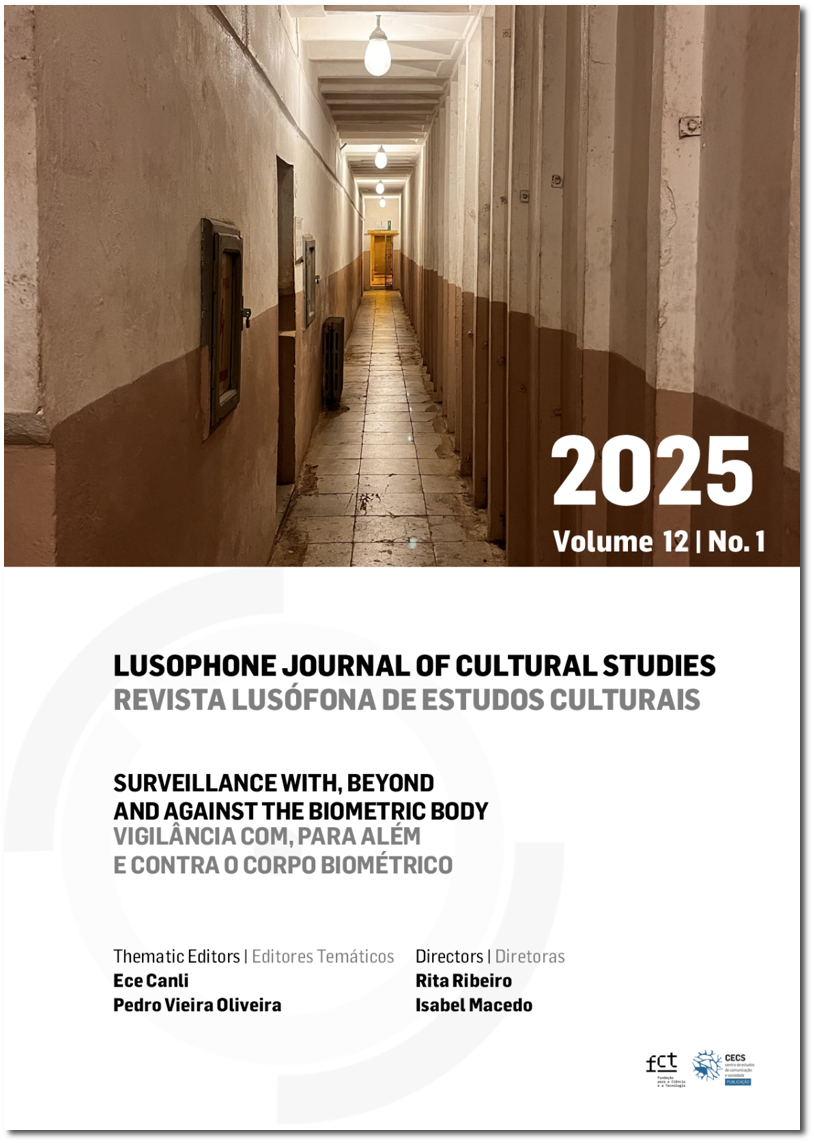Surveillance With, Beyond, and Against the Biometric Body
DOI:
https://doi.org/10.21814/rlec.6654Downloads
References
Abraham, Y. (2023, November 30). ‘A mass assassination factory’: Inside Israel’s calculated bombing of Gaza. +972 Magazine Online. https://www.972mag.com/mass-assassination-factory-israel-calculated-bombing-gaza/
Amaro, R. (2022). The black technical object: On machine learning and the aspiration of black being. Sternberg Press.
Amoore, L. (2006). Biometric borders: Governing mobilities in the war on terror. Political Geography, 25(3), 336–351. http://dx.doi.org/10.1016/j.polgeo.2006.02.001 DOI: https://doi.org/10.1016/j.polgeo.2006.02.001
Ball, K., Haggerty, K., & Lyon, D. (Eds.). (2012). Routledge handbook of surveillance studies. Routledge. DOI: https://doi.org/10.4324/9780203814949
Benjamin, R. (2019). Race after technology: Abolitionist tools for the new Jim code. Polity.
Brighenti, A. M. (2010). Artveillance: At the crossroad of art and surveillance. Surveillance & Society, 7(2), 137–148. https://doi.org/10.24908/ss.v7i2.4142 DOI: https://doi.org/10.24908/ss.v7i2.4142
Browne, S. (2015). Dark matters: On the surveillance of blackness. Duke University Press. DOI: https://doi.org/10.1515/9780822375302
Butler, J. (2016). Precarious life: The powers of mourning and violence. Verso. (Original work published in 2004)
Canlı, E. (2023). Rethinking carceral domesticity: Electronic monitoring, punishment and home as prison. PAD: Pages on Arts and Design Journal, 16, 121–147.
Cole, S. A. (2002). Suspect identities: A history of fingerprinting and criminal identification. Harvard University Press. https://doi.org/10.4159/9780674029682 DOI: https://doi.org/10.4159/9780674029682
Haggerty, K. D., & Ericson, R. V. (2003). The surveillant assemblage. British Journal of Sociology, 51(4), 605–622. https://doi.org/10.1080/00071310020015280 DOI: https://doi.org/10.1080/00071310020015280
Kafer, G., & Grinberg, D. (2019). Editorial: Queer surveillance. Surveillance & Society, 17(5), 592–601. https://doi.org/10.24908/ss.v17i5.13541 DOI: https://doi.org/10.24908/ss.v17i5.13541
Keshavarz, M. (2019). The design politics of the passport: Materiality, immobility, and dissent. Bloomsbury. DOI: https://doi.org/10.5040/9781474289405
Keshavarz, M. (2024). Smuggling as a material critique of borders. Geopolitics, 29(4), 1143–1165. https://doi.org/10.1080/14650045.2023.2268528 DOI: https://doi.org/10.1080/14650045.2023.2268528
Monahan, T. (2017). Ways of being seen: Surveillance art and the interpellation of viewing subjects. Cultural Studies, 32(4), 560–581. https://doi.org/10.1080/09502386.2017.1374424 DOI: https://doi.org/10.1080/09502386.2017.1374424
Monahan, T., & Murakami Wood, D. (Eds.). (2018). Surveillance studies: A reader. Oxford University Press.
Murray, H. (2007). Monstrous play in negative spaces: Illegible bodies and the cultural construction of biometric technology. The Communication Review, 10(4), 347–365. https://doi.org/10.1080/10714420701715415 DOI: https://doi.org/10.1080/10714420701715415
Nemitz, N. (2024, April 9). „Es braucht dringend klare verbote und vorschriften“. Netzpolitik.org Online. https://netzpolitik.org/2024/autonome-waffensysteme-es-braucht-dringend-klare-verbote-und-vorschriften/
Ochoa Gautier, A. M. (2014). Aurality: Listening and knowledge in nineteenth-century Colombia. Duke University Press. https://doi.org/10.2307/j.ctv11smfj3 DOI: https://doi.org/10.1215/9780822376262
Saltes, N. (2013). ‘Abnormal’ bodies on the borders of inclusion: Biopolitics and the paradox of disability surveillance. Surveillance & Society, 11(1/2), 55–73. https://doi.org/10.24908/ss.v11i1/2.4460 DOI: https://doi.org/10.24908/ss.v11i1/2.4460
Steyerl, H. (2011). In free fall: A thought experiment on vertical perspective. e-flux Journal, 24(4), 42–52.
Vieira de Oliveira, P. J. S., & Miyazaki, S. (2022). Maschinelle intelligenz?! Stimmbiometrie als hörend-bestimmende medien-techno-logie. In A. Schürmer, M. Haberer, & T. Brautschek (Eds.), Acoustic intelligence. (pp. 99–124). Düsseldorf University Press. https://doi.org/10.1515/9783110730791-007 DOI: https://doi.org/10.1515/9783110730791-007
Weizman, E. (2002, April 23). Introduction to the politics of verticality. Open Democracy. https://www.opendemocracy.net/en/article_801jsp/
Zuboff, S. (2019). The age of surveillance capitalism: The fight for a human future at the new frontier of power. PublicAffairs.
Downloads
Published
How to Cite
Issue
Section
License
Copyright (c) 2025 Ece Canlı, Pedro J. S. Vieira de Oliveira

This work is licensed under a Creative Commons Attribution 4.0 International License.
Authors own the copyright, providing the journal with the right of first publication. The work is licensed under a Creative Commons - Atribuição 4.0 Internacional License.












